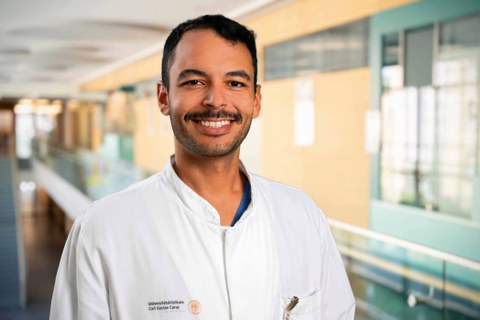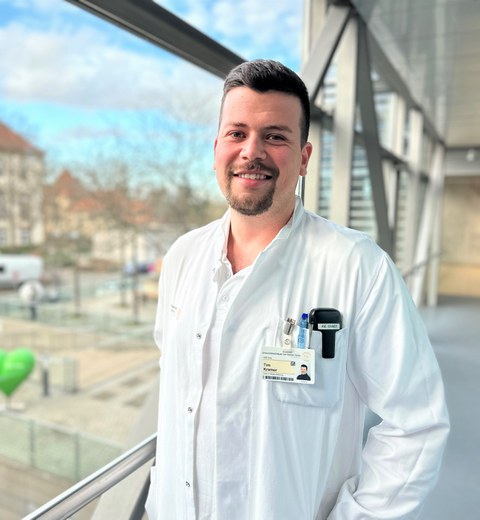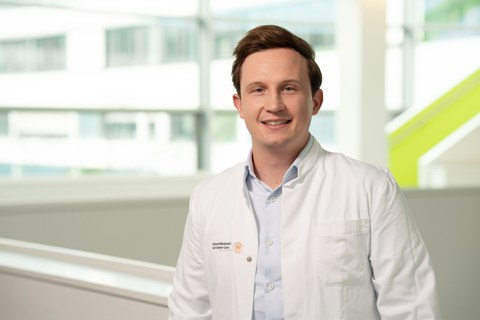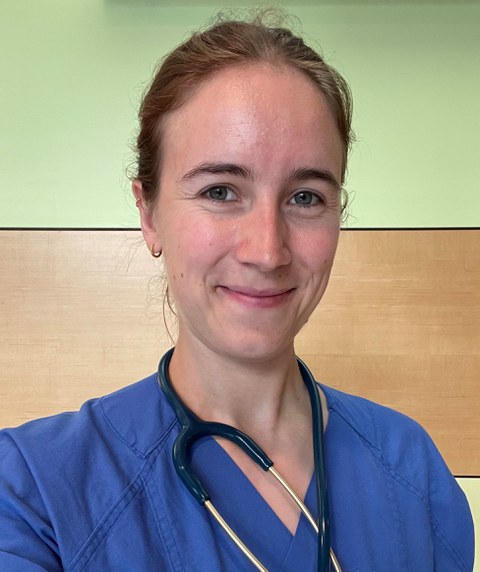Funded scientists 2025/2026
Table of contents
- Funded projects 2025/2026
- Irena Drozd
- Carina Fabian, PhD
- Dr. med. Jan Fischer
- Dr. med. Hernan Inojosa
- Tim Kramer
- Chiara Löffler
- Dr. med. Loreen Natusch
- Dr. med. univ. Dr. rer. medic. Johannes Petzold
- Dr. rer. nat. Astrid Prochnow
- Dr. Jules Schneider
- Dr. med. Martin Schneider
- Dr. med. Hannah Siedel
- Jonas Steinhäuser
- Dr. med. Timmy Strauß
- Dr. med. Wulf Tonnus
- Funded projects 2025/2026
Funded projects 2025/2026
Irena Drozd
Project title: Determining minimally invasive alternatives to glucose, proinsulin and c-peptide in early-stage type 1 diabetes
Structural unit: Department of Paediatrics
Project description
Type 1 diabetes (T1D) is the most common chronic metabolic disease in childhood, affecting around 4 in 1000 children in Germany. The incidence is still rising. T1D is caused by an autoimmune reaction against the insulin-producing beta cells of the pancreas. T1D is often only recognized when serious complications occur. In 2023, 36% of patients at our hospital had ketoacidosis at manifestation, 39% in Saxony and 32% in Germany.
However, the underlying autoimmune process begins months to years before the first symptoms appear. T1D can be diagnosed regardless of the current metabolic situation if at least 2 diabetes-specific antibodies have been detected. Screening for the presence of T1D enables early diagnosis and a life-threatening course of the disease can be prevented by educating families and establishing etabolic controls.
To date, an oral glucose tolerance test (oGTT) has been the main prognostic indicator for the progression of the disease. In our experience, parents, children and adolescents find the oGTT stressful due to its invasiveness and time-consuming nature. To simplify this, several studies have already tested the performance of a capillary oGTT in adults at home. Until now of a capillary oGTT in adults in the home environment. However, there is no published data on the performance of a capillary oGTT in children.
For the planned project, children and adolescents with early stage T1D will be recruited and 2 oGTT will be performed within 3 weeks with the following question:
1) Is an oGTT also feasible in the home setting in perspective?
2) Does the minimally invasive determination of the proinsulin/C-peptide ratio help to identify children who become insulin-dependent more quickly?
Performing the oGTT in the home setting would reduce the burden on families and ease the burden on the healthcare system. If screening is expanded, more and more children and adolescents with an early stage of T1D can be identified.
Carina Fabian, PhD
Project title: The role of EGFL7 in Glioblastoma cell invasion
Structural unit: Institute of Anatomy
Project description
A major challenge for an effective treatment of the malignant brain tumor glioblastoma (GBM) is its invasive potential, which does not allow a curative tumor resection. This highlights the urgent need to identify novel therapeutic targets.
One such factor could be the epidermal growth factor-like protein 7 (EGFL7), an endothelial cell-secreted angiogenic factor deposited into the extracellular matrix, which promotes neurogenesis and angiogenesis. Interestingly, EGFL7 was shown to affect the invasion of different cancer types.
To see if EGFL7 also influences GBM cell invasion, we will employ cellular models with different invasion capacities, including patient-derived GBM cell lines and orthotopic xenografts. As GBM cells do not express EGFL7, the first step will be to generate EGFL7 overexpression models. Next, in vitro transwell and spheroid assays, ex vivo brain slice cultures and in vivo mouse models will be implemented to study the impact of EGFL7 on GBM cell invasion. Moreover, sectioning and immunohistochemical staining of the murine brain and flow cytometry will be performed to quantitatively analyze GBM invasion. Moreover, invasive and non-invasive cells will be sorted out of the brain and subjected to RNA sequencing to determine differently expressed genes and potential interaction partners of EGFL7. This will help to identify novel drug targets, which will be tested in combination with the anti-EGFL7 antibody parsatuzumab for their potential to synergistically decrease the invasive potential of GBM cells.
Further information: https://tu-dresden.de/med/mf/ana/forschung
Dr. med. Jan Fischer
Project title: Identification and description of a novel hereditary autosomal dominant ataxia
Structural unit: Institute for Clinical Genetics
Project description
The project aims to identify and characterize a new heritable ataxia by studying a multitude of closely related individuals presenting with progressive impairments of motor coordination, gait and speech. Autosomal-dominant ataxias are a group of neurodegenerative disorders affecting the cerebellum and are frequently caused by genetic alterations, including repetitive DNA sequences known as short tandem repeats (STRs). Despite the availability of advanced diagnostic methods like short-read genome sequencing, a large proportion of hereditary ataxia cases, like the aforementioned patient cohort, remain without an identifiable genetic diagnosis. This is due to the limitations in detecting certain genetic variants, particularly STRs, but also due to the fact that many causative genes have not been identified.
To overcome this challenge, the project will employ long-read sequencing technologies capable of capturing repetitive DNA regions and identifying repeat expansions. Complementary bioinformatic analyses will help further focus the search to specific genomic regions shared by affected individuals, especially focusing on genes with significant expression in the cerebellum. This may allow for the identification of a novel genetic cause in order to give new insights into disease mechanisms and pathogenesis of hereditary ataxias. The unique availability of closely related individuals provides an exceptional opportunity to study shared genetic factors and establish a clear link between genotype and phenotype. Long-term, the project aims to establish an international patient cohort to validate the findings, thereby contributing to improved diagnostic accuracy and prognosis as well as elucidating potential therapeutic approaches.
Dr. med. Hernan Inojosa
Project title: Bridging Brain Age Gap as Marker of Neurondestruction in Multiple Sclerosis: A novel Artificial Intelligence-based multidimensional approach integrating Clinical and Serum Biomarkers
Structural unit: Department of Neurology
Project description
The MeDDrive project "Bridging Brain Age Gap as Marker of Neurodegeneration in Multiple Sclerosis" focuses on the Brain Age Gap (BAG) – the difference between the brain's biological and chronological age. BAG has been linked to worse clinical outcomes, such as cognitive decline and functional impairments, in areas like stroke and dementia research. In Multiple Sclerosis, BAG could serve as an important early marker for neurodegenerative processes or accelerated aging, with significant implications for prognosis and therapy planning.
We collaborate closely with our partners, including the Else Kröner Fresenius Center (EKFZ) for Digital Health and jung diagnostics GmbH. The project aims to validate an AI-based model for calculating biological brain age using MRI data. Furthermore, we explore the correlation of BAG with clinical, serological and structural markers such as Glial fibrillary acidic protein (GFAP), optical coherence tomography (OCT), and multimodal gait analysis.
By integrating these data, we seek to enhance personalized therapy planning and improve the prediction of disease progression in MS, ultimately advancing BAG as an innovative biomarker for clinical practice.
Further information: https://zkn.uniklinikum-dresden.de/
Tim Kramer
Project title: Effects of non-intubated, assisted one-lung-ventilation in pigs (OLVspont)
Structural unit: Department of Anesthesiology and Intensive Care Medicine
Project description
Lung surgery can be challenging not only for the surgeon but also for the anesthetist. Due to the operation on one lung, only the other one is available for ventilation. Post-operative pulmonary complications (PPC) due to one-lung ventilation (OLV) occur in up to 46% of patients. This is 4-5 times more frequent than with other procedures. In addition, the damage to the operated lung caused by the surgery is unavoidable and adds to this.
The relatively new procedure of non-intubated OLV and video-assisted thoracoscopy (NIVATS) makes such operations possible without endotracheal intubation while maintaining spontaneous breathing. Whether the elimination of the potentially damaging controlled, intubated OLV is actually associated with less pronounced or even prevented ventilator-induced lung injury, and is therefore actually lung-protective at the parenchymal level, is unknown.
In a randomized, controlled animal experiment, we simulate thoracic surgery. Ventilation and airway management are performed according to clinical standards in controlled, intubated OLV in one group, and in the sense of NIVATS with preserved spontaneous breathing and a laryngeal mask in the other group. Regular computed tomography scans, analyses of ventilation mechanics and blood gas analyses during the procedure, show the effects on gas distribution, lung mechanics and oxygenation. In addition, the extent of structural and inflammatory damage to the lungs will be determined by postprocedural histological examinations and positron emission tomography.
We hope that this work will provide deeper insights into a ventilation strategy that has the potential to minimize the perioperative risk of patients who are particularly dependent on good function of their non-operated lung.
Link to the website: www.uniklinikum-dresden.de/de/das-klinikum/kliniken-polikliniken-institute/ane/forschung
Chiara Löffler
Project title: Histology- and ctDNA-based risk stratification for colorectal cancer
Structural unit: Else Kröner-Fresenius Center for Digital Health / Department of internal Medicine I
Project description
Artificial intelligence (AI), in particular deep learning (DL), is revolutionizing oncology by enabling the analysis of complex medical data such as histopathological images and molecular biomarkers. These innovative approaches often reveal patterns invisible to humans and provide new insights into cancer prognosis and treatment.
The HIBRID project aims to improve the stratification of patients with colorectal cancer by combining DL analyses of histological data with biomarkers of circulating tumor DNA (ctDNA). A predictive DL risk score will be developed based on anonymized data from two independent international cohorts. High-risk patients can thus be identified at an early stage and treated with individually tailored therapies. In addition to this main objective, the project also plans to investigate other clinically relevant issues in further phases, such as the temporal dynamics of ctDNA and their influence on treatment decisions.
Link to the website: https: //linktr.ee/chiara.loef
Dr. med. Loreen Natusch
Project title: The effect of the intratumoral microbiome on the immune cell infiltrate of pancreatic cancer
Structural unit: Department of Visceral, Thoracic and Vascular Surgery
Project description
Pancreatic ductal adenocarcinoma (PDAC) has a devastating prognosis with a 5-year survival rate of 13%. New therapies have so far not brought any resounding success. One reason for this is a complex tumor milieu that is still poorly understood. One potential factor that could influence this complex construct is the microbiome in the tumor tissue. Intratumoral bacterial colonization has been demonstrated for numerous cancers. In addition, it has been shown in various cancer entities that both tumor progression and response to certain therapies are related to the intratumoral microbiome. Immunohistochemical staining was used to identify immunological niches in PDAC, with these immunologically hot areas showing significantly stronger bacterial colonization. Eradication of the T-cells led to a significant decrease in the microbial infiltrate, suggesting a direct link between T-cells and the microbiome.
The aim of this project is to investigate the microbial composition by specifically analyzing the taxonomy of both tumor and normal tissue as well as the adjacent secretions (pancreatic, bile and duodenal secretions). Specifically, the influence of intratumoral bacterial and mycotic colonization on the density and localization of cytotoxic CD8+ T cells and the expression of inhibitory immune checkpoints will be analyzed. By analyzing the microbial composition of anatomically adjacent regions of the pancreas, their potential influence on the intratumoral microbiome will be investigated.
Dr. med. univ. Dr. rer. medic. Johannes Petzold
Project title: Feasibility and potential effectiveness of group parent training as new part of integrated care for parents with methamphetamine use disorder
Structural unit: Department of Psychiatry and Psychotherapy
Project description
Methamphetamine use continues to rise on a global scale and has already reached epidemic proportions in numerous countries around the world. This escalation places an enormous burden on consuming individuals, their children, families, and communities, as methamphetamine is a rapidly increasing cause of criminality, morbidity, and mortality.
Given the healthcare uptake is very low and too late in this vulnerable population, the initiative “Mommy, think of me!” (MAMADAM, an acronym formed from “Mama, denk an mich!”) seized the unique opportunities of pregnancy and parenthood to support pregnant women and new mothers in stopping methamphetamine use for the sake of their children. MAMADAM evolved into low-barrier integrated care for expecting and new parents with methamphetamine use disorder, provided by the Departments of Psychiatry, Obstetrics, and Pediatrics at the Carl Gustav Carus University Hospital Dresden in cooperation with the community-based counseling centers for substance use concerns and government-based child welfare services.
MeDDrive funding allows for evaluating the feasibility and potential effectiveness of the group parent training SHIFT as a new part of MAMADAM, thereby helping gear methamphetamine-specific integrated care toward the recovery and resilience of the whole family.
Dr. rer. nat. Astrid Prochnow
Project title: Neurophysiological Predictors in the Pharmacological Treatment of ADHD: The Role of Voluntary Theta Band Modulability for MPH Responsiveness
Structural unit: Department of Child and Adolescent Psychiatry and Psychotherapy
Project description
In the treatment of ADHD, a common psychiatric disorder in children and adolescents, not all patients benefit equally from the first-line treatment with methylphenidate (MPH). A more individualized selection of pharmacological treatment could therefore help those affected and their families. The project aims to investigate whether the effectiveness of MPH can be predicted before treatment begins, based on voluntary control over one's brain activity. A study with healthy adults has already shown that after a single dose of MPH, those participants who demonstrated high voluntary modulability of the theta frequency band exhibited better inhibition performance. Building on this previous finding, the study will also assess the voluntary modulability of the theta frequency band, symptoms, and inhibition ability in patients with ADHD before a planned treatment with MPH. Eight weeks after the start of the treatment, symptoms and inhibition ability will be reassessed. If patients with better modulability of the theta frequency band benefit more from MPH treatment, this could serve as the basis for a more individualized medication selection.
Dr. Jules Schneider
Project title: Sleeping soundly: auditory stimulation of sleep oscillations in bipolar disorder
Structural unit: Department of Psychotherapy and Psychosomatic Medicine
Project description
Bipolar disorder (BD) is a severe mood disorder characterised by recurrent (hypo-) manic and depressive episodes. BD affects over 1% of the world’s population, whose quality of life, physical health and cognitive functioning are significantly impaired by the condition. Cognitively, individuals with BD commonly experience deficits in memory, executive function and attention, irrespective of present mood episode type. Moreover, sleep abnormalities (both macro- and microstructure, i.e. sleep stages and brain oscillations) are highly prevalent in BD. Intriguingly, research from our group suggests sleep disturbances in BD frequently precede disorder onset by several years, pointing toward a potentially causal role of sleep in disorder aetiology. Sleep plays a crucial restorative role in supporting healthy cognitive functioning. Specific sleep oscillations, particularly slow waves and sleep spindles, which facilitate efficient cognitive daytime performance through overnight consolidation processes, are altered in BD.
Over the past decade, a non-invasive technique termed closed-loop auditory stimulation (CLAS) was developed to enhance specific sleep oscillations. CLAS tracks on-going activity of the sleeping brain via EEG and delivers brief acoustic stimuli timed to co-occur with neuronal depolarisation to enhance slow wave and spindle activity, with ensuing cognitive benefits. It has thus far yielded promising results in various patient groups, including depression, schizophrenia, and epilepsy, but has yet to be tested in individuals with BD. This project will apply CLAS in an outpatient group of individuals with BD as an early proof-of-concept study, paving the way for future novel sleep interventions in BD.
Link to the website: https://www.researchgate.net/profile/Jules-Schneider-2
Dr. med. Martin Schneider
Project Title: Deep Learning-Based Whole Slide Imaging Analysis of Bone Marrow Histologies for the Identification of Digital Biomarkers and the Prediction of Therapy Response and Overall Survival
Department: Department of Internal Medicine I
The analysis of bone marrow smears and biopsies is fundamental for the diagnosis and therapeutic monitoring of acute myeloid leukemia (AML). However, current methods are time-consuming, require specialized expertise, and are subject to diagnostic variability.
Deep learning offers the potential to detect complex patterns and automate diagnostic processes. In previous work by our research group, a deep learning model was successfully developed to detect AML based on bone marrow smears. To date, however, no such applications exist for bone marrow histologies. Given their preserved microenvironment and cellular composition, histologies may provide crucial insights for improved diagnostics, including the identification of digital biomarkers and risk stratification regarding therapy response and overall survival.
This project aims to develop a deep learning model for the analysis of AML histologies in collaboration with the Helmholtz Center Munich, the LMU Munich University Hospital, and the University Hospital Erlangen.
Dr. med. Hannah Siedel
Project title: Characterisation of NLRP3-, AIM2- und NLRC4 Inflammasome activity of preterm and term neonates
Structural unit: Department of Paediatrics
Project description
The Inflammasome-Caspase-1-signaling pathways are part of the innate immune system. After activation, this proinflammatory signaling pathways lead to a release of interleukin-1β (IL-1β). They are involved in the pathogenesis of a variety of diseases. However, there is a yet unresolved contradiction between reduced activation of caspase-1 activity in neonates and the development of neonatal diseases such as bronchopulmonary dysplasia (BPD) or hypoxic ischaemic encephalopathy (HIE), in which increased caspase-1 activity following inflammasome activation is involved in the pathogenesis.
In this project, the inflammasome-caspase-1 signaling pathways (NLRP3, AIM2 and NLRC4) in premature and mature neonates will be characterized in detail using an established whole blood assay. Whole blood and umbilical cord blood samples from preterm and term born infants will be analyzed in comparison to whole blood from healthy young adults.
The aim of the project is to better understand the peri- and postnatal role of inflammasome activation in premature and newborn infants. The results of the study may provide therapy-relevant insights into the pathogenesis of pro-inflammatory diseases of premature infants and newborns.
Jonas Steinhäuser
Project title: A Foundation Model Endoscopic Retrograde Cholangiopancreatography (ERCP) – Video analysis of endoscopic examinations using artificial intelligence
Structural unit: Else Kröner-Fresenius Center for Digital Health / Department of internal Medicine I
Project description
Endoscopic retrograde cholangiopancreatography (ERCP) is a complex diagnostic and therapeutic procedure used to investigate and treat pathologies of the pancreatobiliary system. Two of the more common complications associated with this procedure are delayed post-interventional bleeding and post-ERCP pancreatitis. Currently, reliable prognostic markers for accurately predicting the risk of these complications are lacking, necessitating close post-interventional monitoring of patients.
This project aims to develop a foundation model, a type of artificial intelligence (AI) algorithm based on self-supervised learning, that can analyze ERCP endoscopic videos to predict the likelihood of these complications. This approach aims to ease the workload of medical staff and enhance patient safety.
Dr. med. Timmy Strauß
Project title: Secondary Pneumonia in Early Life: System immunological characterization of the early immune response in (secondary) bacterial pneumonia in childhood and adolescence
Structural unit: Department of Paediatrics
Project description
Since the corona pandemic, there is an increasing number of bacterial pneumonia in children and adolescents and, in addition to classic pathogens such as S. pneumoniae and H. influenzae, unexpectedly often also include invasive group A streptococci. In this connection, the role of primary viral infections is still unclear. Through specific immune dysregulation, reduction of mucosal immunity and destruction of the mucosal barrier, primary viral infections can have a decisive influence on individual immunological strategies against bacteria.
The aim of this project is to elucidate the predisposing factors for a severe course of pneumonia by combining a mass cytometric measurement procedure and automated data analysis. The target group consists of children and adolescents suffering from severe pneumonia, with and without evidence of a primary viral infection. By analysing clinical and experimental data, we use machine learning to extract meaningful predictors that allow us to predict the susceptibility and course of secondary pneumonia. Furthermore, we aim to reveal virus-specific pathomechanisms by creating immune response profiles, which will lead to more effective therapy strategies in the long term.
Dr. med. Wulf Tonnus
Project title: NINJ1-mediated membrane rupture as a regulatory event in ferroptosis upon AKI
Structural unit: Department of internal Medicine III, Department of Nephrology
Project description
Chronic kidney disease (CKD) is prevalent in up to 850.000.000 persons worldwide, and has been identified as a leading cause of lethality. Therapeutic progress has been made to reduce constant decline of renal function like in diabetic nephropathy. However, acute kidney injury (AKI) episodes result in irreversible function loss without therapeutic options beyond supportive measures, and, thus, remain a major determinant of CKD progression. We and others found that highly regulated cell death routines determine structural renal injury, especially within the tubular compartment. Opposing past assumptions, both apoptosis and necrosis are tightly controlled processes, leaving cell death-targeted therapies an attractive option. In contrast to caspase-mediated routines such as apoptosis and necroptosis, ferroptosis is caused by iron-mediated lipid peroxidation, which needs to be constantly antagonized by systems such as GPX4 and AIFM2. During AKI, yet, these systems fail and tubules undergo ferroptotic demise. As typical for a necrotic form of cell death, plasma membrane integrity is lost early during ferroptosis, which leads to the release of intracellular content activating innate immune cells. Vice versa, these cells again modulate ongoing cell death, a concept termed necroinflammation. Interestingly, regulatory mechanisms downstream of lipid peroxidation have been identified recently to protect against plasma membrane rupture. Whereas a share of damaged membranes is removed by the ESCRT machinery to antagonize necrosis, NINJ1 was identified to control plasma membrane rupture in all forms of regulated cell death. NINJ1 features two transmembrane regions and an N-terminal oligomerization domain, rendering NINJ1 therapeutically targetable. However, most research focused on innate immune cells, whereas the role of NINJ1 in epithelial cells, such as renal tubules, and their impact on necroinflammation remain largely undefined. In this project, we will leverage cell culture approaches, renal tubular organoids, translational mouse models, and human renal biopsies to investigate the role of NINJ1 on ferroptotic cell death upon AKI.














